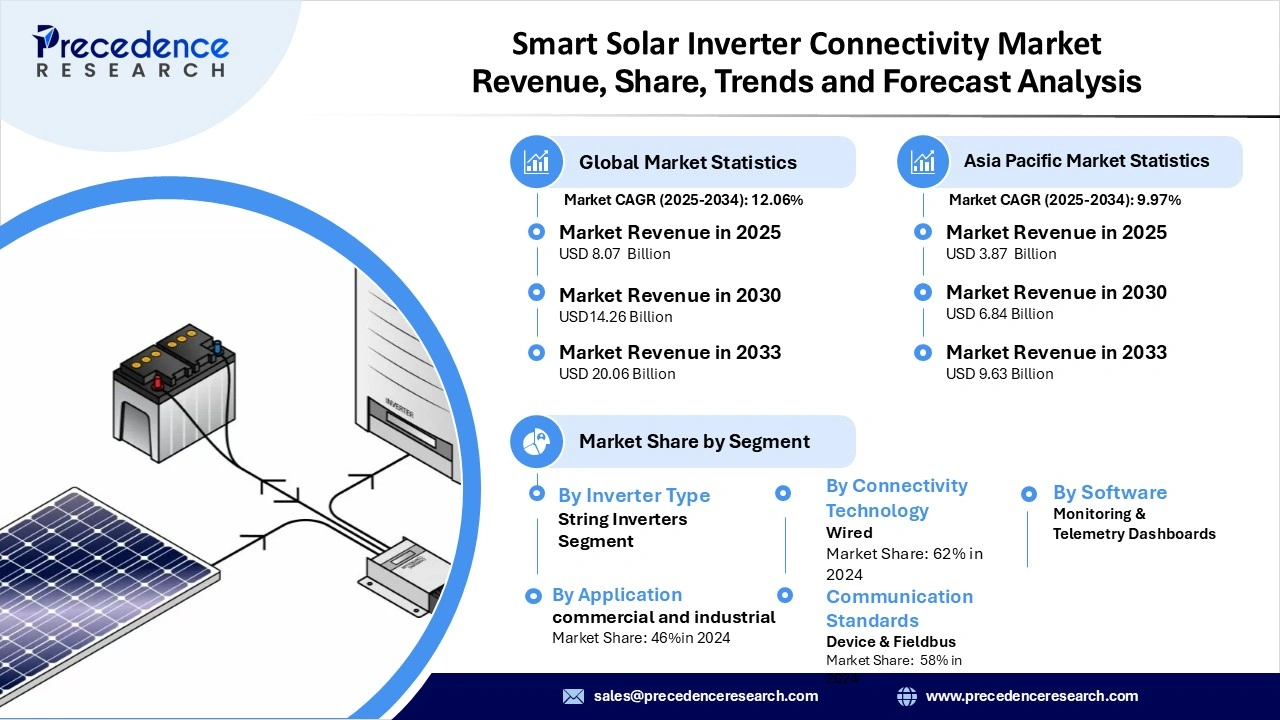Smart Solar Inverter Connectivity Market Revenue to Attain USD 20.06 Bn by 2033
Smart Solar Inverter Connectivity Market Revenue and Trends 2025 to 2033
The global smart solar inverter connectivity market revenue reached USD 8.07 billion in 2025 and is predicted to attain around USD 20.06 billion by 2033 with a CAGR of 12.06%. The market growth is attributed to the rapid proliferation of distributed solar generation, increasing demand for grid flexibility, and the rising integration of IoT and AI technologies in energy systems, all of which are accelerating the adoption of smart connectivity in solar inverters.

What are the Key Factors Driving the Smart Solar Inverter Connectivity Market?
One of the main driving factors is the increased emphasis on grid resilience and the integration of distributed energy resources, in essence, making everything more resilient and distributed. Utilities and system operators are increasingly requesting that inverters send status updates, fault notifications, and control commands to help maintain balance and grid stability. The growing adoption of IoT, Artificial Intelligence , and edge analytics in solar systems is also contributing significantly. These technologies enable predictive maintenance, fault detection, and real-time performance optimization, resulting in operational savings, whether in materials, labor, or time.
Government support and incentives for smart grid modernization across various jurisdictions are further encouraging the development of advanced inverter connectivity applications. At the same time, the falling costs of communication modules and improved interoperability (thanks to open standards and protocols) are making these connectivity upgrades more feasible and worth exploring. Finally, as cybersecurity, energy efficiency, and carbon reduction continue to receive increased attention, more stakeholders are prioritizing the development of smarter, better-connected solar systems.
Segment Outlook:
- By inverter type, the string inverters segment dominated the market in 2024, driven by its widespread adoption in both small-scale installations and utility-scale projects requiring modular, scalable connectivity solutions.
- By connectivity technology, the wired segment led the market in 2024, as technologies such as Ethernet and fieldbus wiring offer high-bandwidth, low-latency, and highly reliable communication, particularly critical in commercial and industrial applications.
- By software, the monitoring & telemetry dashboards segment held the largest share in 2024, fueled by growing demand for intuitive interfaces that allow real-time performance tracking, system alerts, and remote diagnostics.
- By application, the commercial & industrial segment dominated in 2024, owing to the reliance of large-scale rooftop and ground-mounted solar installations on robust connectivity for system scaling, remote monitoring, and predictive maintenance.
- By communication standards, the device & fieldbus segment led the market in 2024, supported by the widespread use of industrial standards like Modbus, Profibus, and other fieldbus protocols in smart energy systems.
Regional Insights:
Asia Pacific dominated the smart solar inverter connectivity market in 2024 primarily due to its rapid expansion of solar capacity, particularly in key countries like China, India, and Southeast Asia. The region’s strong focus on grid modernization and the growing demand for smart energy infrastructure further accelerated market growth. Government policies played a crucial role, with many countries setting ambitious renewable energy targets and offering subsidies to promote smart grid deployment. Additionally, Asia-Pacific’s investment in local manufacturing capabilities for connected modules and inverter products reduced costs and improved supply chain efficiency. The adoption of advanced technologies such as IoT and AI in solar systems also enhanced predictive maintenance and grid stability, making smart inverter connectivity more attractive.
Smart Solar Inverter Connectivity Market Coverage
| Report Attribute | Key Statistics |
| Market Revenue in 2025 | USD 8.07 Billion |
| Market Revenue by 2033 | USD 20.06 Billion |
| CAGR from 2025 to 2033 | 12.06% |
| Quantitative Units | Revenue in USD million/billion, Volume in units |
| Largest Market | Asia Pacific |
| Base Year | 2025 |
| Regions Covered | North America, Europe, Asia-Pacific, Latin America, and the Middle East & Africa |
Recent Developments:
- On October 10, 2025, Saatvik Green launched its UDAY on-grid inverter series, offering single-phase 1.1–6 kW and three-phase 6–50 kW smart inverters for residential, commercial, and industrial use. (Source-https://www.pv-magazine.com)
Get this report to explore global market size, share, CAGR, and trends, featuring detailed segmental analysis and an insightful competitive landscape overview @ https://www.precedenceresearch.com/sample/6997
You can place an order or ask any questions, please feel free to contact us at sales@precedenceresearch.com |+1 804 441 9344